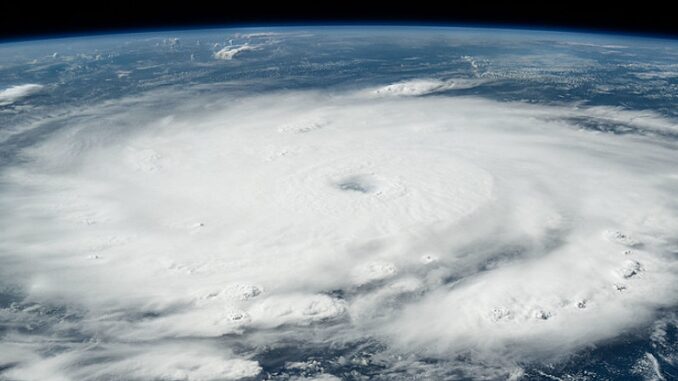
MIAMI, Florida, July 4, 2024 (ENS) – Hurricane Beryl, now causing havoc across the Caribbean, is the earliest storm on record to hit Category 5 with sustained winds of 157 mph, the highest classification on the Saffir-Simpson Scale. Beryl has killed at least 22 people and left ruin behind as it spins westward from Jamaica toward Mexico’s Yucatan Peninsula.
Beryl became a major hurricane on June 30. On Monday, July 1, Beryl made landfall on the island of Carriacou, Grenada in the eastern Caribbean, with sustained winds of 150 mph (240 km/h). The next day, July 2, Beryl intensified into a Category 5 hurricane, peaking a few hours later with winds of 165 mph (270 km/h). Later that same day, Beryl passed south of Isla Beata, Dominican Republic, where it weakened to Category 4 strength.
In Grenada, Prime Minister Dickon Mitchell told a news conference on Tuesday that Carriacou has been all but cut off, with houses, telecommunications and fuel facilities there flattened. Two of the three deaths recorded in Grenada happened on Carriacou, he said.
“The situation is grim,” Mitchell said. “There is no power and there is almost complete destruction of homes and buildings on the island. The roads are not passable, and in many instances, they are cut off because of the large quantity of debris strewn all over the streets. The possibility that there may be more fatalities remains a grim reality as movement is still highly restricted.”
One of the homes that Beryl damaged in Carriacou belongs to the family of United Nations Climate Change Executive Secretary Simon Stiell, a native of Carriacou.
His late grandmother’s home was destroyed, and his parents’ property was damaged, Stiell’s office told the Agence France Press news agency

In a statement, Stiell said the climate crisis is worsening faster than expected. “Whether in my homeland of Carriacou, hammered by Hurricane Beryl, or in the heatwaves and floods crippling communities in some of the world’s largest economies, it’s clear that the climate crisis is pushing disasters to record-breaking new levels of destruction,” he said.
“Disasters on a scale that used to be the stuff of science fiction are becoming meteorological facts, and the climate crisis is the chief culprit,” Stiell added.
In St. Vincent and the Grenadines, Prime Minister Ralph Gonsalves said Hurricane Beryl left “immense destruction” in its wake, including 90 percent of homes on Union Island.
An initial report in the insurance publication “Claims Journal” estimates that Beryl has already caused over $1 billion in economic losses.
The World Health Organization reports that 1,032 people in Saint Vincent and the Grenadines required evacuation as well as 2,500 in Grenada, and 129 in Trinidad and Tobago.
Saint Vincent and the Grenadines counted three deaths, and experienced widespread devastation. More than 90 percent of structures across the nation’s islands were damaged or destroyed.
Beryl’s center passed close to the southern coast of Jamaica on the afternoon of July 3, claiming two lives while remaining a Category 4 hurricane. High winds and rain smashed homes and businesses, ripped down powerlines and uprooted trees. At least one person were killed on the island, while another went missing after he was washed away by floods. The Jamaican Public Service Company stated that over 400,000 people were without power. The capital city, Kingston, lost most of its power.
Now, large swells generated by Hurricane Beryl are impacting portions of the coasts of Jamaica, Cuba, the Cayman Islands, and the Yucatan Peninsula. The swells are expected to reach eastern Mexico and much of the Gulf Coast of the United States by late Friday. “These swells are expected to cause life-threatening surf and rip current conditions,” warns the U.S. National Hurricane Center in Miami.
Currently, a Hurricane Warning is in effect for the coast of the Yucatan Peninsula of Mexico from Puerto Costa Maya to Cancun, including Cozumel.
A Hurricane Warning means that hurricane conditions are expected somewhere within the warning area. Preparations to protect life and property should be rushed to completion. Mexican naval officers told people in tourist areas, in Spanish and in English, to get ready for the storm’s arrival, and Mexico is evacuating people from some coastal areas.
A Hurricane Watch is in effect for the coast of the Yucatan Peninsula of Mexico south of Puerto Costa Maya to Chetumal, and north of Cancun to Cabo Catoche.
A Hurricane Watch means that hurricane conditions are possible within the watch area.
A Tropical Storm Warning is in effect for the coast of the Yucatan Peninsula south of Puerto Costa Maya to Chetumal and north of Cancun to Campeche.
A Tropical Storm Warning means that tropical storm conditions are expected somewhere within the warning area, in this case within 24 hours.
A Tropical Storm Watch is in effect for the coast of Belize from south of Chetumal to Belize City.
A Tropical Storm Watch means that tropical storm conditions are possible within the watch area.
“Interests elsewhere in the northwestern Caribbean Sea and the western Gulf of Mexico, including southern Texas and northeastern Mexico, should closely monitor the progress of Beryl,” the Hurricane Center advises today.
Scientists said climate change contributed to Beryl’s early formation and rapid intensification.
Global warming has helped push temperatures in the North Atlantic to record highs, said Christopher Rozoff, an atmospheric scientist at the US-based National Center for Atmospheric Research in Colorado, said.
The warmer waters lead to more evaporation, which fuels more intense hurricanes featuring higher wind speeds, he said.
“The oceanic warmth is what we’d expect in early September, the time of year the tropical North Atlantic’s main developmental region’s heat is building toward its annual maximum,” Rozoff told TIME magazine. “Warm sea surface temperatures are conducive to providing the lower atmosphere the heat and moisture that fuel tropical storm systems.”
Next, Hurricane Beryl is forecast to blast a path from Yucatan, Mexico to the central Texas coast before it weakens and dissipates over land.

Featured image: Hurricane Beryl, the earliest storm on record to reach Category 5, the highest class on the Saffir-Simpson Scale, is blasting across the Caribbean Sea. July 1, 2024 (Image courtesy NASA’s Johnson Space Station)
© 2024, Environment News Service. All rights reserved. Content may be quoted only with proper attribution and a direct link to the original article. Full reproduction is prohibited.



